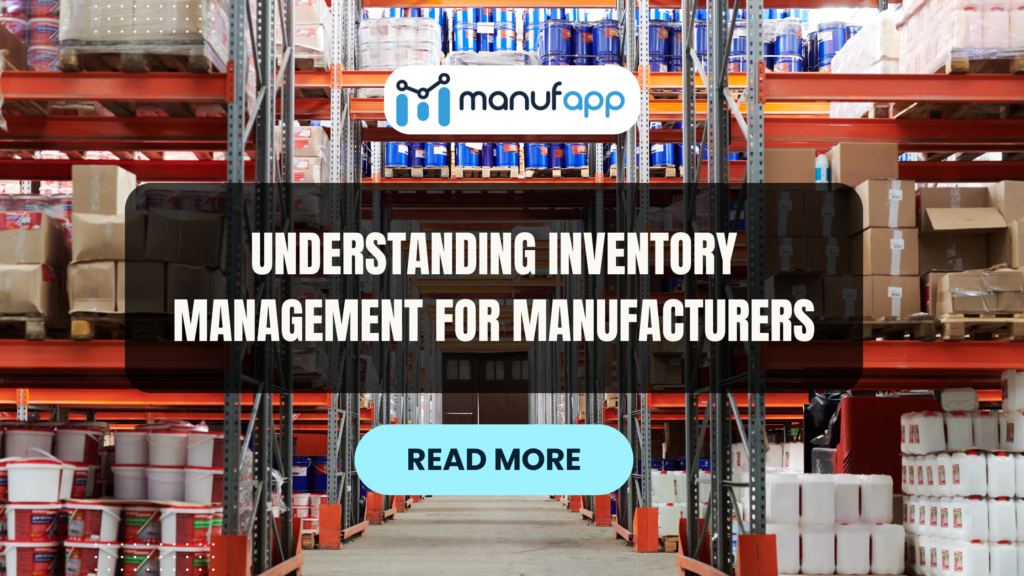ABSTRACT:
Effective inventory management is essential for manufacturing entities as it impacts operational efficiency, cost management, and customer satisfaction. For effective management of inventory, it is first important to understand what inventory is and what are the types of inventories. This article provides a comprehensive overview of inventory, exploring key concepts such as inventory types and the significance of inventory. Additionally, it discusses poor inventory management and reasons for poor inventory management. Understanding these components, enables manufacturers to optimize their inventory processes, reduce costs, and enhance overall performance.
INTRODUCTION:
For any manufacturing entity, inventory management plays a crucial role in ensuring that the production process runs efficiently and smoothly. The primary goal of inventory management is to have the right amount of inventory at the right time to meet production demands and customer needs, knowing when to sell and at what price while also minimizing costs for the manufacturing entity.
WHAT IS INVENTORY?
Inventory refers to the raw materials, work-in-progress (WIP) items, and finished goods that a business holds for the purpose of production, sale, or future use. It is a critical asset for manufacturers that represents a significant portion of their capital investment. Inventory can be categorized into 4 types, each serving a distinct purpose in the production and sales process.
- Raw Materials- Raw materials are the primary inputs required in the manufacturing of products. These can include metals, chemicals, plastics, and other components that are processed and transformed either into intermediate/semi-finished goods or finished goods. Effective management of raw materials is crucial to ensure a continuous production flow.
- Work-in-Progress (WIP)- Work-in-progress inventory consists of partially completed products that are still undergoing manufacturing processes. Managing WIP inventory efficiently helps in reducing production lead times and improving workflow efficiency.
- Finished Goods- Finished goods are completed products that are ready for sale and consumption by the end customers. Maintaining an optimal level of finished goods inventory is essential to meet customer demand without overstocking, which can lead to increased holding costs.
- Maintenance, Repair, and Operations (MRO)- MRO inventory includes items used in the production process that do not form part of the final product. This can include spare parts, lubricants, tools, and other supplies required for maintaining the production equipment.
IMPORTANCE OF INVENTORY MANAGEMENT FOR MANUFACTURERS:
Inventory is a critical component of the manufacturing process as it poses various implications on business operations of a manufacturing entity.
- Ensuring Continuous Production- Maintaining adequate levels of raw materials and WIP inventory ensures that the production process runs smoothly without interruptions. This is vital for meeting production schedules and fulfilling customer orders on time.
- Meeting Customer Demand- Maintaining sufficient finished goods inventory allows manufacturers to meet customer demands promptly; this leads in achievement of customer satisfaction and builds a loyal customer base. This is also helpful in preventing loss of sales due to stockouts.
- Cost Management- Efficient inventory management helps in optimizing the cost of holding and ordering inventory. Manufacturers can minimize storage costs, reduce wastage, and avoid excess inventory by managing inventory levels.
- Attaining Competitive Advantage- The business environment has increasingly become dynamic and manufacturers who incorporate efficient inventory management systems can respond more quickly to market changes and customer needs and preferences, which helps them attain a competitive edge. This agility can lead to increased market share and profitability over time.
- Supply Chain Efficiency- Proper inventory management systems enhance the supply chain efficiency by ensuring that materials and products are available as and when required. This coordination between suppliers, manufacturers, and distributors leads to smoother operations and lower overall costs.
WHAT IS POOR INVENTORY MANAGEMENT?
Poor inventory management is an imbalance between keeping too much and too little inventory which is known as – ‘Overproduction’ and ‘Underproduction’. To avoid such a situation, it is important to understand and analyze the ongoing and upcoming market trends and customer demands and accordingly produce the optimum level. Both overproduction and underproduction pose significant challenges that can impact a manufacturer’s operational efficiency, costs, and customer satisfaction.
WHY SHOULD INVENTORY LEVELS BE MANAGED?
OVERPRODUCTION – Situation wherein the manufacturer produces more units than the actual market demand, leading to excess inventory which has negative implications such as:
- Increased Holding Costs- Holding costs are the expenses associated with storing unsold inventory. These costs include warehousing, insurance, security, and maintenance. Excess inventory requires additional storage space and resources, thereby increasing these costs. Prolonged holding can also tie up capital that could be invested elsewhere in the business.
- Risk of Obsolescence– Excess inventory that is being stored for a long period of time is at a risk of becoming obsolete. This is especially seen when the product has a short life cycle or products with rapid technological advancements. Obsolete inventory may need to be sold at a discount or written off entirely, resulting in financial losses.
- Quality Degradation– Products that are perishable or those with shelf-life constraints, can degrade over time if not sold promptly. This deterioration can lead to waste and potential reputational damage if customers receive substandard products.
UNDERPRODUCTION – Situation wherein the manufacturer produces less units than the actual market demand, leading to shortage of inventory which has negative implications such as:
- Stockouts and Lost Sales- Insufficient inventory levels can lead to stockouts, where products are unavailable for sale when customers want to purchase them, this can result in lost sales, as customers may turn to competitors to fulfil their needs. This not only impacts immediate revenue but can also impact long-term customer loyalty.
- Increased Expediting Costs- To mitigate the effects of underproduction, manufacturers may resort to accelerating/expediting orders or ramping up production quickly. This often results in overtime labour, premium shipping costs, and rushed procurement of raw materials, which can be significantly more expensive than standard production processes.
- Operational Disruptions- Underproduction leads to inefficient use of production resources like machinery, labour, and other resources. These may be underutilized, leading to lower overall productivity and higher per-unit costs.
REASONS FOR POOR INVENTORY MANAGEMENT:
- Inaccurate Demand Forecasting- This leads to either overproduction or underproduction. Without proper forecasting, manufacturers may fail to anticipate market demand accurately, resulting in inventory imbalances.
- Lack of Visibility- Timely visibility into inventory levels and movements can help achieve effective management. Without real-time data, manufacturers may struggle to track and report inventory accurately, leading to stockouts or overstocking.
- Inefficient Processes- Inefficient inventory management processes, can include manual data entry, tracking and outdated systems, leading to errors and delays. These methods can be time-consuming and labour-intensive. Streamlining these processes through automation and technology integration can improve accuracy and efficiency.
- Poor Supplier Relationships- Unreliable suppliers or poor communication with suppliers can disrupt the supply chain and lead to inventory shortages or delays. This can happen when there is untimely supply of raw materials or inputs which halts the production process and result in stockouts. Building strong relationships and maintaining clear communication with suppliers is crucial for ensuring timely deliveries to consumers.
- Overreliance on Safety Stock- Although, safety stock is essential for managing uncertainties, overreliance on it can lead to excessive inventory levels and increased holding costs. Manufacturers need to find a balance between safety stock and demand forecasting. This can also result in inventory obsolescence and wastage.
- Poor Inventory Turnover- Indicates that products are not being sold or used quickly enough, leading to excess inventory. This can result from various factors, including poor sales strategies, incorrect demand forecasting, and inefficient production planning.
- Lack of Technology Integration- Resistance to adopt new technology can lead to inefficiencies and inaccuracies. Integrating advanced technologies can streamline processes and provide real-time visibility into inventory levels.


